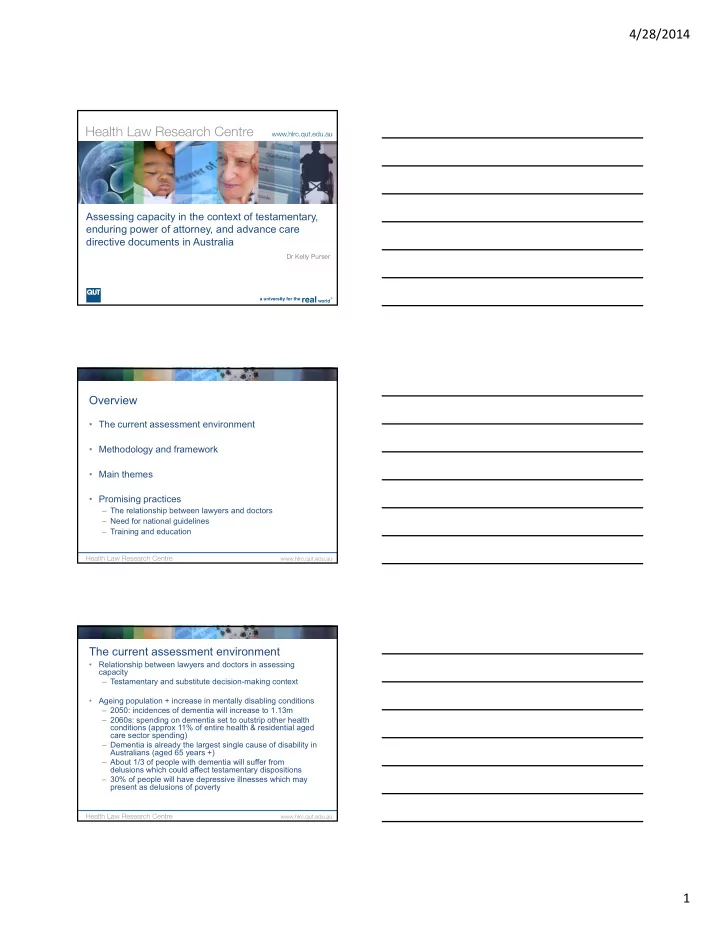

4/28/2014 Assessing capacity in the context of testamentary, enduring power of attorney, and advance care directive documents in Australia Dr Kelly Purser Overview • The current assessment environment • Methodology and framework • Main themes • Promising practices – The relationship between lawyers and doctors – Need for national guidelines – Training and education The current assessment environment • Relationship between lawyers and doctors in assessing capacity – Testamentary and substitute decision-making context • Ageing population + increase in mentally disabling conditions – 2050: incidences of dementia will increase to 1.13m – 2060s: spending on dementia set to outstrip other health p g p conditions (approx 11% of entire health & residential aged care sector spending) – Dementia is already the largest single cause of disability in Australians (aged 65 years +) – About 1/3 of people with dementia will suffer from delusions which could affect testamentary dispositions – 30% of people will have depressive illnesses which may present as delusions of poverty 1
4/28/2014 Current approach to assessments • No nationally accepted assessment guidelines/principles • Terminological and methodological miscommunication and misunderstanding • Assessments undertaken on an ad hoc basis – Jurisdiction and practitioner – Jurisdiction and practitioner • Issue of individual autonomy v protection • ‘Should there be a Commonwealth or nationally consistent approach to defining and assessing capacity and assessing a person’s ability to exercise their legal capacity? If so, what is the most appropriate mechanism and what are the key elements?’ – ALRC, ‘Equality, Capacity and Disability in Commonwealth Laws’ Issues Paper Nov 2013 Methodology • Doctrinal analysis current legal position – Secondary sources, cases, legislation • Empirical research – practising (specialist) lawyers and doctors surveyed, interviewed – 20 doctors Australia wide – 10 lawyers Australia wide • Suggestions made for ‘promising practices’ Main themes • The relationship between lawyers and doctors • The utility of national guidelines • What such guidelines should contain • Training and education 2
4/28/2014 The relationship between lawyers and doctors Both But, lack of: professions: The relationship between lawyers and doctors • Constraints: time, budgets, fees • Issue of litigation and liability – Expectation and fear of involvement Expectation and fear of involvement • The impact of miscommunication and misunderstanding on assessments Clarification needed • Clear definitions and instructions – What is being assessed? – For what purpose? – What information is needed/expected format of report? • Who should be responsible for assessments – Need for interdisciplinary approach – Role of each profession should be clarified – Strengthen relationship between professions • Best practice model - national guidelines 3
4/28/2014 Need for national guidelines? • National guidelines • 3 stages: (1) Initial legal assessment (1) Initial legal assessment (2) Clinical assessment (if necessary) (3) Final determination of legal capacity • Guiding principles National Guidelines • Consider: definitions, triggers, lifestyle, morals, format of instructions and report • Assessment: individual’s ability to understand, appreciate, reason/justify and communicate the decision • Weigh: – The individual s ability to receive, understand, retain and recall relevant The individual’s ability to receive understand retain and recall relevant information – Select between options – Understand the reasons for the decision – Apply the information received to the individual’s circumstances – Evaluate the benefits and risks of the choice – Communicate, and then persevere with, that choice (at least until the decision is acted upon) • Interaction of legal and medical professionals in assessing legal capacity Training and education • Clear communication necessary • Increase knowledge and understanding • Professional training • Community education 4
4/28/2014 In summary • Current situation = ad hoc assessment • Ageing population + mentally disabling conditions increasing • Need for flexible approach acknowledging Need for flexible approach acknowledging current environment: – National paradigm – Strengthening relationship between legal and medical professionals – Increased training and education 5
Recommend
More recommend